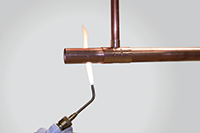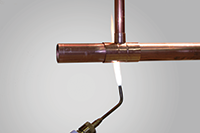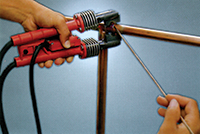WARNING: When dealing with an open flame, high temperatures and flammable gases, safety precautions must be observed as described in ANSI/AWS Z49.1.
Begin heating with the flame perpendicular to the tube (Figure 7.18, position 1 and Figure 7.13). The copper tube conducts the initial heat into the fitting cup for even distribution of heat in the joint area. The extent of this preheating depends upon the size of the joint. Preheating of the assembly should include the entire circumference of the tube in order to bring the entire assembly up to a suitable preheat condition. However, for joints in the horizontal position, avoid directly preheating the top of the joint to avoid burning the soldering flux. The natural tendency for heat to rise will ensure adequate preheat of the top of the assembly. Experience will indicate the amount of heat and the time needed.
Next, move the flame onto the fitting cup (Figure 7.18, position 2 and Figure 7.14). Sweep the flame alternately between the fitting cup and the tube a distance equal to the depth of the fitting cup (Figure 7.18, position 3). Again, preheating the circumference of the assembly as described above, with the torch at the base of the fitting cup (Figure 7.18, position 4), touch the solder to the joint. If the solder does not melt, remove it and continue heating.
 Figure 7.13. Preheating Tube
Figure 7.13. Preheating Tube Figure 7.14. Preheating Fitting
Figure 7.14. Preheating FittingCAUTION: Do not overheat the joint or direct the flame into the face of the fitting cup. Overheating could burn the flux, which will destroy its effectiveness and the solder will not enter the joint properly.
When the solder melts, apply heat to the base of the cup to aid capillary action in drawing the molten solder into the cup towards the heat source.
 Figure 7.15. Electric Resistance Hand Tool
Figure 7.15. Electric Resistance Hand Tool Figure 7.18. Schematic of Solder Joint
Figure 7.18. Schematic of Solder JointThe heat is generally applied using an air-fuel torch. Such torches use acetylene or an LP gas. Electric resistance soldering tools can also be used (Figure 7.15 above). They employ heating electrodes and should be considered when an open flame is a concern.
